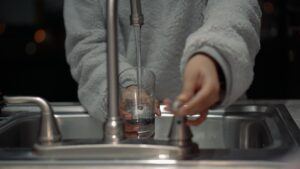 A new commentary focuses on water insecurity in communities where residents live with persistent problems such as lead in the water system or unreliable water treatment.
A new commentary focuses on water insecurity in communities where residents live with persistent problems such as lead in the water system or unreliable water treatment.
Water security refers to having stable access to available, acceptable, and safe drinking water, which is key for supporting good nutrition. One way to address water insecurity for families with low income is through the U.S. Department of Agriculture Supplemental Nutrition Assistance Program (SNAP).
Research has found that poor water quality and failing water infrastructure disproportionately impact populations with low income in rural settings and communities of color. Families with low income that have unsafe or unreliable public water sources resort to purchasing bottled drinking water or water treatment devices in addition to paying their home water bill.
This commentary highlights policy strategies that could leverage SNAP for safe home drinking water access for families with low income. Under existing federal SNAP policy, the program could 1) provide water quality education for SNAP participants and teach them about the importance of testing private wells; and 2) provide supplemental state funding via the electronic benefit transfer (EBT) system to participants in communities that lack access to safe drinking water.
In looking at strategies that will require federal or regulatory changes, the program could 1) adjust the Thrifty Food Plan formula (the SNAP allotment) to account for areas with low access to safe drinking water; and 2) permit the use of SNAP benefits for water filter purchases and container deposits for bulk bottled water.
The authors conclude that water security and safe water are integral to good nutrition and safe preparation of food. Disparate home access to safe and accessible tap water is a crucial healthy equity issue. There is a need for policies that ensure that families can affordably access safe drinking water, and this can be addressed with the team’s proposed strategies via the several avenues within SNAP.
Ensuring access to low-cost, safe, and appealing drinking water at home can support public health efforts to reduce consumption of sugary drinks, which can help children and youth maintain a healthy weight.
Citation:
Wilking C, Nink E, Cradock AL. Drinking Water and the Supplemental Nutrition Assistance Program: Current Policy and Opportunities for Improvement. JPHMP. December 2021. doi:10.1097/PHH.0000000000001474
This paper is part of the Safe Home Drinking Water project.